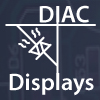Active Matrix Limitations
DIAC Technology vs. Active Matrix Technology
LEDs and OLEDs provide light in proportion to current. As non-linear devices, the voltage across an LED or OLED does not provide a well characterized control mechanism. DIACs are current devices offering inherent compatibility with LEDs and OLEDs. A DIAC display illumination cell is capacitively coupled and produces light in pulses. As the LED or OLED is illuminated, the illumination cell's capacitance is charged according to the flow through the LED or OLED. The power and brightness of each light pulse is limited by the charging of this capacitance.
Active matrix technology is challenged by the current based nature of OLEDs. Our goal is that the widely used Active Matrix Thin Film Transistor (AMTFT) process can be converted from transistor technology to a DIAC technology.
Within an active matrix, thin film transistors (TFTs) control the pixel brightness. TFTs were designed for voltage controlled liquid crystal displays (LCDs). TFTs were not designed to supply the current needed by OLEDs. Active Matrix OLED Displays (AMOLED) control OLED current by operating the TFTs in a linear range. TFTs were also not designed to operate in a linear range where power is dissipated. Thus, the design of TFTs at the higher currents of large displays present many challenges for the technology.
